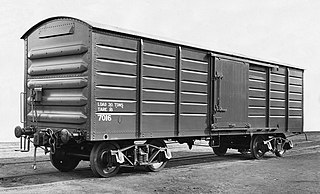
A railroad car, railcar, railway wagon, railway carriage, railway truck, railwagon, railcarriage or railtruck, also called a train car, train wagon, train carriage or train truck, is a vehicle used for the carrying of cargo or passengers on a rail transport network. Such cars, when coupled together and hauled by one or more locomotives, form a train. Alternatively, some passenger cars are self-propelled in which case they may be either single railcars or make up multiple units.

A boxcar is the North American (AAR) term for a railroad car that is enclosed and generally used to carry freight. The boxcar, while not the simplest freight car design, is considered one of the most versatile since it can carry most loads. Boxcars have side sliding doors of varying size and operation, and some include end doors and adjustable bulkheads to load very large items.

A hopper car (US) or hopper wagon (UIC) is a type of railroad freight car used to transport loose bulk commodities such as coal, ore, grain, and track ballast. Two main types of hopper car exist: covered hopper cars, which are equipped with a roof, and open hopper cars, which do not have a roof.

A bulk carrier or bulker is a merchant ship specially designed to transport unpackaged bulk cargo—such as grain, coal, ore, steel coils, and cement—in its cargo holds. Since the first specialized bulk carrier was built in 1852, economic forces have led to increased size and sophistication of these ships. Today's bulk carriers are specially designed to maximize capacity, safety, efficiency, and durability.

Bulk material handling is an engineering field that is centered on the design of equipment used for the handling of dry materials. Bulk materials are those dry materials which are powdery, granular or lumpy in nature, and are stored in heaps. Examples of bulk materials are minerals, ores, coal, cereals, woodchips, sand, gravel, clay, cement, ash, salt, chemicals, grain, sugar, flour and stone in loose bulk form. It can also relate to the handling of mixed wastes. Bulk material handling is an essential part of all industries that process bulk ingredients, including: food, beverage, confectionery, pet food, animal feed, tobacco, chemical, agricultural, polymer, plastic, rubber, ceramic, electronics, metals, minerals, paint, paper, textiles and more.

In North American railroad terminology, a gondola is an open-topped rail vehicle used for transporting loose bulk materials. Because of their low side walls, gondolas are also suitable for the carriage of such high-density cargos as steel plates or coils, or of bulky items such as prefabricated sections of rail track. Gondolas are distinct from hopper cars in that they do not have doors on their floor to empty cargo.

A dry bulk cargo barge is a barge designed to carry freight such as coal, ores, grain, sand or gravel, or similar materials. Barges are usually constructed of steel. They have an outer hull, and one or more internal holds. A rake barge has a bow shaped to cause less resistance when being pushed and is usually placed at the head of the tow. A box barge has no rake to the ends and is usually placed in the center and rear of the tow and can hold more cargo.

Hawker Siddeley Canada was the Canadian unit of the Hawker Siddeley Group of the United Kingdom and manufactured railcars, subway cars, streetcars, aircraft engines and ships from the 1960s to 1980s.

A rotary car dumper or wagon tippler (UK) is a mechanism used for unloading certain railroad cars such as hopper cars, gondolas or mine cars. It holds the rail car to a section of track and then rotates the track and car together to dump out the contents. Used with gondola cars, it is making open hopper cars obsolete. Because hopper cars require sloped chutes in order to direct the contents to the bottom dump doors (hatches) for unloading, gondola cars allow cars to be lower, thus lowering their center of gravity, while carrying the same gross rail load. Cars are equipped with rotary couplers to allow dumping them while they are still coupled; a "Double Rotary" gondola or hopper has rotary couplers on both ends to allow it to be unloaded while it remains coupled to stationary cars at each end.

Rail freight transport is the use of railroads and trains to transport cargo as opposed to human passengers.

Bulk cargo is commodity cargo that is transported unpackaged in large quantities.

A silo is a structure for storing bulk materials. Silos are used in agriculture to store fermented feed known as silage, not to be confused with a grain bin, which is used to store grains. Silos are commonly used for bulk storage of grain, coal, cement, carbon black, woodchips, food products and sawdust. Three types of silos are in widespread use today: tower silos, bunker silos, and bag silos.

A hopper barge is a type of barge commonly designed to transport commodities like coal, steel, rocks, sand, soil and waste. 'Hopper barge' can also refer to a barge that dumps cargo at sea. These are now commonly called 'split hopper barge', because they split along the length of the hull. Split hopper barges can be non-propelled or self-propelled.

A semi-trailer is a trailer without a front axle. The combination of a semi-trailer and a tractor truck is called a semi-trailer truck.

Handysize is a naval architecture term for smaller bulk carriers or oil tanker with deadweight of up to 50,000 tonnes, although there is no official definition in terms of exact tonnages. Handysize is also sometimes used to refer to the span of up to 60,000 tons, with the vessels above 35,000 tonnes referred to as Handymax or Supramax.

Open wagons form a large group of railway goods wagons designed primarily for the transportation of bulk goods that are not moisture-retentive and can usually be tipped, dumped or shovelled. The International Union of Railways (UIC) distinguishes between ordinary wagons and special wagons (F/6). Open wagons often form a significant part of a railway company's goods wagon fleet; for example, forming just under 40% of the Deutsche Bahn's total goods wagon stock in Germany.
The International Union of Railways groups all special classes of railway goods wagon into Class U in its goods wagon classification system.
The Victorian Railways in Australia have had a vast range of hopper-type wagons over the last century, for transporting anything from grains through fuel to various powders.
The wagon with opening roof is a type of railway goods wagon that is, nowadays, defined and standardised by the International Union of Railways (UIC) as Class "T". They are a large category of rail vehicle, predominantly used for the transport of hygroscopic bulk commodities such as cement, plaster, lime, potash and grain.

A grain hopper trailer is a trailer pulled by a semi tractor and used to haul bulk commodity products, such as grain. These trailers are used extensively throughout the United States to transport agricultural products as well as any other commodity that can be hauled in bulk and loaded and unloaded through the trailer.





















